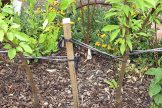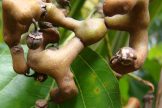
 Important note about plant availability. Important note about plant availability.There are hundreds of factsheets on our website provided for your information. Not all plants will be available at all times throughout the year. To confirm availability please call (03) 8850 3030 and ask for the nursery. |
The avocado is a versatile and nutritious fruit that, apart from being the perfect baby food, is high in vitamin C, full of anti-oxidants, great for our skin and a good source of beneficial mono-unsaturated fats and folic acid. The avocado tree is a generous, shady evergreen tree that may be pruned as little or as much as you require.
Generally regarded as a fruit of more tropical climes, many varieties of avocado will do just fine in Melbourne, as long as the soil and drainage is just right.
Avocados despise ‘wet feet’, so improve the drainage of your heavy clay soil with gypsum and compost well before planting, and consider planting on a slope, or a mound. Soil-wise, a slightly acid to neutral pH is fine… so aim for about 5.5 – 7 for best results.
Choose a frost-free position and remember that many avocados can reach a height of 5 – 10m at maturity, so be sure to leave enough room. Over our warm Melbourne summers you may find your avocado looking a bit average, especially in the first few years. Avocados aren’t known for their vigorous root systems and this can cause the tree to dry out much more quickly than many other plants. Keep the water up to them when it’s really hot (in accordance with local water restrictions of course).
The other thing to remember about avocados is that each variety has a different flowering habit. This sees avocados categorized into two groups, A and B. Avocados are partially self-fertile, which means they may produce a bit of fruit on their own, but their yields will be increased if you can plant one tree of each group.
However, you only need to plant an A and B type if daytime temperatures remain above 20 degrees Celsius and night time temperatures remain above 10 degrees Celsius at all times during flowering.
The three main types of avocados are Guatemalan, Mexican and West Indian. Bacon is one of the Mexican varieties of avocados, these are the hardiest group and most tolerant of cold conditions. Mature trees can tolerate temperatures to –5 C without damage, Guatemalan types are the next cold tolerant and can withstand light frosts to –2 C, while .West Indian varieties are most frost sensitive. Fuerte is another frost tolerant variety that is thought to be a natural hybrid between the Mexican and Guatemalan avocadoes. Both Bacon and Fuerte are type B avocados. Cold tolerance is related to the place origin, many type A avocados are Guatemalan hybrids, so no, there’s no type A as cold tolerant as these!
Avocados are not small trees, Wurtz is the only variety suitable for growing in a large pot, as it is a dwarf tree which grows to around 4m in the ground, the semi-dwarf Lamb Hass is taller than that in the ground. Choose Wurtz if you want a type A avocado in a pot. Frost tolerance is not an issue as you can move the pot under cover if you get very cold weather, or simply cover the tree as it won’t get much over 2.5m in a pot!
Feeding avocados in Melbourne
The best way to apply fertiliser is to sprinkle it by hand evenly underneath the tree’s drip-zone and a bit further out, as this where the trees feeder roots are. Don’t dig in the fertiliser or cultivate the soil around the roots as avocados have a shallow fibrous feeding root system close to the surface, with almost all feeder roots in the top 15-20cm of soil.
If you use mulch around the tree, which is highly recommended in the warmer seasons, apply the fertiliser under the mulch for best results. Just push the mulch aside, apply the fertiliser and then move the mulch back in place. After applying fertiliser, always remember to water it in.
Avocados have special feeding requirements, as young trees require small amounts of fertilisers regularly to grow well.
Year 1-2: Apply a fertiliser high in nitrogen such as chicken manure or blood & bone every 8 weeks or 2-3 times during the growing season from November to March to promote vegetative growth (leaves and branches).
Apply a very small amount of fertiliser to begin with, then use more fertiliser on the second application. If adding a third application of fertiliser around March, add a small amount only. A third light application of fertiliser in March is highly recommended as all fruit trees need a feed in the beginning of the autumn season.
Year 3 onwards: Fertilise as before but use a more balanced fertiliser instead that will supply the trees nitrogen, phosphorus and potassium needs.
You can continue to use chicken manure or blood & bone which supply nitrogen and phosphorus as long as you add potash (or supplement with seaweed extract which contains high potash levels). Use approximately 3L of chicken manure and 20g of potash per tree per year. Don’t apply it all at once, use a portion each time you feed the tree as per previous instructions.
Other balanced fertilisers that are suitable for avocados include citrus fertiliser or a general purpose organic fertiliser. Feeding your avocado regularly will allow the tree to achieve optimum growth and fruit productively as early as possible.
How long before my avocado has fruit?
For a grafted tree you should start getting fruit 3 to 4 years after planting, not many at first, but by 7 years you should be harvesting a lot of fruit. For a seedling grown tree, it can take between 5 and 13 years before fruiting commences.
How to tell when an avocado is ripe
Avocados ripen once harvested, and depending on the variety this can take around 7 to 10 days.
The Hass begins its life like other avocados, smooth and green, however, as they mature the skin turns that classic pebbly purple/black colour. The trick is to understand that NO avocado ripens on the tree, you need to pick the avocado to start the final ripening process. The avocado will mature on the tree (grow and develop) but not ripen. Thus you can use the tree as a holding place, just pick the avocados as you need them and leave the rest on the tree (this is within reason, leave them too long and they will fall off the tree and not be much good). Hass matures over winter. Once the fruit looks like it has reached full size (after winter) pick the largest one (it will be rock hard) and keep it inside to initiate the ripening process. To test when ripe – hold in your hand and gently squeeze (with your whole hand – don’t poke it with your thumb – you will bruise it), if there is a tiny bit of give, it is ready. Generally the fruit will turn from green to purple, and when purple is ready to eat. If the fruit never ripens, just sort of shrivels and turns to rubber, it wasn’t mature enough on the tree, wait a bit longer before you pick the next one. If you are in a hurry try putting it in a paper bag with a ripe banana, the ethylene is trapped and increases the rate of ripening.
 Important note about plant availability. Important note about plant availability.There are hundreds of factsheets on our website provided for your information. Not all plants will be available at all times throughout the year. To confirm availability please call (03) 8850 3030 and ask for the nursery. |
Avocado – Bacon (B Flowering Variety): The best cold tolerant avocado, bacon will grow to a manageable height of 4m in our cooler Melbourne climate. Fruit is a medium size and quality and appears on the tree from June – late July. Unlike most other avocados the fruit will fall from the tree when ripe. Can bear fruit in Melbourne in as little as 4 years.
Avocado – Fuerte (B Flowering Variety): Another great cold tolerant variety, Fuerte produces small, pear shaped fruit with a dark green skin and a fabulous nutty flavour. Fuerte can be quite a large, spreading tree reaching a height of about 8m x 12m, so give it some space. Fuerte has a tendency to produce fruit every second year (between June and October), and can take about 6 years to produce fruit in Melbourne.
Avocado – Hass (A Flowering Variety): Possibly the most popular of all avocados, Hass bears incredibly flavoursome fruits that keep well. A handsome tree to about 9m x 10m, Hass is fairly cold and frost tolerant once established, and will bear delicious fruit between September and January.
Avocado – Lamb Hass (A Flowering Variety): Very similar in appearance to Hass, with the very dark pebbly skin. The flesh is a pale green and slightly creamier than the Hass. Maturing 4-12 weeks later then the Hass and consistently producing a heavier crop than Hass.
Avocado – Pinkerton (A Flowering Variety): Bears very heavy crops of medium sized fruit. protect from frosts when young, may be cold tolerant once established, Pinkerton will bear fruit from June – August.
Avocado – Reed (A Flowering Variety): Large, round, thick skinned variety with a smooth, green skin and a rich flavour. Reed avocados store well in the fridge once cut. This variety grows to a manageable 4m x 2m, and will bear fruit after 3 years or so. Fruit matures between November and March.
Avocado – Wurtz (A Flowering Variety): A gorgeous small tree for gardens, Wurtz is a popular variety of avocado, prized for it’s rich, flavoursome fruit. Possibly a better performer in climates warmer than Melbourne, Wurtz is nevertheless a favourite of Melbourne gardeners.





